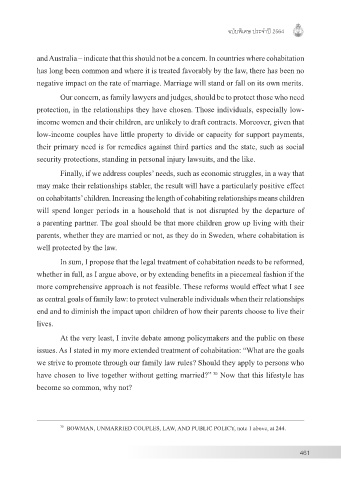Page 463 - วารสารกฎหมาย ศาลอุทธรณ์คดีชํานัญพิเศษ
P. 463
ฉบับพิเศษ ประจำ�ปี 2564
and Australia – indicate that this should not be a concern. In countries where cohabitation
has long been common and where it is treated favorably by the law, there has been no
negative impact on the rate of marriage. Marriage will stand or fall on its own merits.
Our concern, as family lawyers and judges, should be to protect those who need
protection, in the relationships they have chosen. Those individuals, especially low-
income women and their children, are unlikely to draft contracts. Moreover, given that
low-income couples have little property to divide or capacity for support payments,
their primary need is for remedies against third parties and the state, such as social
security protections, standing in personal injury lawsuits, and the like.
Finally, if we address couples’ needs, such as economic struggles, in a way that
may make their relationships stabler, the result will have a particularly positive effect
on cohabitants’ children. Increasing the length of cohabiting relationships means children
will spend longer periods in a household that is not disrupted by the departure of
a parenting partner. The goal should be that more children grow up living with their
parents, whether they are married or not, as they do in Sweden, where cohabitation is
well protected by the law.
In sum, I propose that the legal treatment of cohabitation needs to be reformed,
whether in full, as I argue above, or by extending benefits in a piecemeal fashion if the
more comprehensive approach is not feasible. These reforms would effect what I see
as central goals of family law: to protect vulnerable individuals when their relationships
end and to diminish the impact upon children of how their parents choose to live their
lives.
At the very least, I invite debate among policymakers and the public on these
issues. As I stated in my more extended treatment of cohabitation: “What are the goals
we strive to promote through our family law rules? Should they apply to persons who
have chosen to live together without getting married?” Now that this lifestyle has
30
become so common, why not?
30 BOWMAN, UNMARRIED COUPLES, LAW, AND PUBLIC POLICY, note 1 above, at 244.
461

